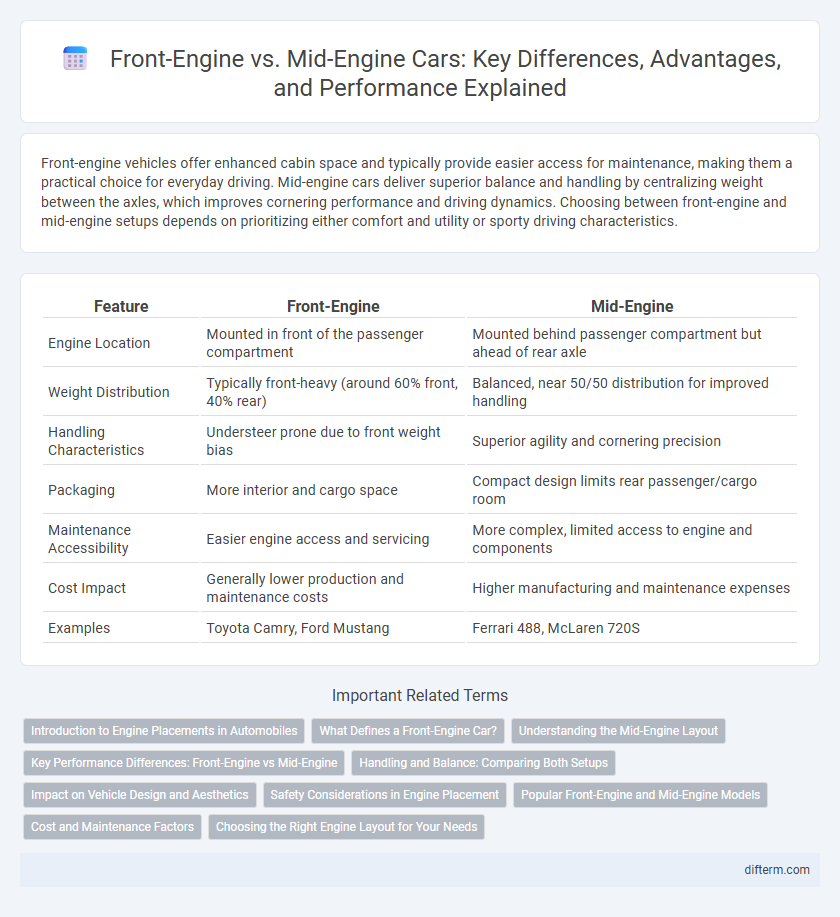Front-engine vehicles offer enhanced cabin space and typically provide easier access for maintenance, making them a practical choice for everyday driving. Mid-engine cars deliver superior balance and handling by centralizing weight between the axles, which improves cornering performance and driving dynamics. Choosing between front-engine and mid-engine setups depends on prioritizing either comfort and utility or sporty driving characteristics.
Table of Comparison
| Feature | Front-Engine | Mid-Engine |
|---|---|---|
| Engine Location | Mounted in front of the passenger compartment | Mounted behind passenger compartment but ahead of rear axle |
| Weight Distribution | Typically front-heavy (around 60% front, 40% rear) | Balanced, near 50/50 distribution for improved handling |
| Handling Characteristics | Understeer prone due to front weight bias | Superior agility and cornering precision |
| Packaging | More interior and cargo space | Compact design limits rear passenger/cargo room |
| Maintenance Accessibility | Easier engine access and servicing | More complex, limited access to engine and components |
| Cost Impact | Generally lower production and maintenance costs | Higher manufacturing and maintenance expenses |
| Examples | Toyota Camry, Ford Mustang | Ferrari 488, McLaren 720S |
Introduction to Engine Placements in Automobiles
Front-engine designs position the engine ahead of the passenger compartment, optimizing cabin space and simplifying cooling system layout, which enhances everyday drivability and ease of maintenance. Mid-engine layouts place the engine between the front and rear axles, typically behind the driver, improving weight distribution and handling dynamics for superior performance and cornering stability. Understanding these placements helps in evaluating vehicle design priorities related to balance, traction, and driving experience in sports and regular automobiles.
What Defines a Front-Engine Car?
A front-engine car is defined by its engine placement ahead of the front axle, typically under the hood, directly influencing weight distribution and handling characteristics. This configuration enhances cabin space and simplifies drivetrain design, making it prevalent in sedans, SUVs, and many sports cars. Key models featuring front-engine layouts include the Toyota Camry, Ford Mustang, and Chevrolet Corvette.
Understanding the Mid-Engine Layout
The mid-engine layout positions the engine between the front and rear axles, typically behind the driver, optimizing weight distribution for superior handling and balance. This configuration reduces the car's moment of inertia, enhancing cornering stability and responsiveness compared to front-engine designs. Mid-engine vehicles often deliver improved traction and performance, making them favored in high-performance sports cars and race cars.
Key Performance Differences: Front-Engine vs Mid-Engine
Front-engine vehicles typically offer better weight distribution for everyday driving, enhancing stability and comfort, while mid-engine designs prioritize balanced weight distribution and lower center of gravity, resulting in superior handling and cornering performance. Mid-engine cars excel in agility and responsiveness due to their centralized mass, which reduces understeer and improves acceleration dynamics. Front-engine layouts often provide increased cabin space and easier maintenance, but sacrifice some precision and sharpness in high-performance scenarios compared to mid-engine counterparts.
Handling and Balance: Comparing Both Setups
Front-engine vehicles typically offer predictable handling with more weight over the front tires, enhancing traction during cornering and braking. Mid-engine configurations centralize mass between the axles, resulting in superior balance, quicker steering response, and improved cornering agility. The mid-engine layout often provides a lower polar moment of inertia, which significantly enhances vehicle dynamics compared to front-engine setups.
Impact on Vehicle Design and Aesthetics
Front-engine layouts prioritize spacious cabin design and larger trunk capacity, influencing overall vehicle proportions with a longer hood and balanced frontal mass. Mid-engine configurations centralize engine placement behind the driver, enhancing aerodynamics and achieving a sleek, aggressive silhouette favored in high-performance sports cars. This layout shifts weight distribution towards the center, resulting in a lower center of gravity and dynamic vehicle stance that profoundly impacts chassis design and visual appeal.
Safety Considerations in Engine Placement
Front-engine vehicles offer enhanced crash protection due to the engine acting as a buffer during frontal collisions, improving occupant safety. Mid-engine layouts centralize mass between axles, increasing vehicle stability and handling precision but may reduce frontal crash zones. Engineers balance these factors with structural reinforcements and advanced safety systems to optimize occupant protection in various crash scenarios.
Popular Front-Engine and Mid-Engine Models
Popular front-engine models such as the Toyota Camry, Honda Accord, and Ford Mustang dominate the automotive market with their balanced weight distribution and easier maintenance. Mid-engine vehicles like the Ferrari 488, Porsche Cayman, and Lamborghini Huracan offer superior handling and performance by placing the engine near the center of the chassis. This design enhances agility and cornering stability, making mid-engine sports cars a top choice for enthusiasts seeking precision driving dynamics.
Cost and Maintenance Factors
Front-engine vehicles typically offer lower initial costs and simpler maintenance due to more accessible engine placement and widely available parts. Mid-engine cars often involve higher purchase prices and increased maintenance expenses because of complex layouts and specialized components. The ease of servicing front-engine models generally translates to reduced long-term ownership costs compared to mid-engine configurations.
Choosing the Right Engine Layout for Your Needs
Front-engine layouts offer practicality with better cabin space and easier maintenance, ideal for daily driving and family vehicles. Mid-engine configurations enhance handling and weight distribution, providing superior performance for sports cars and track enthusiasts. Evaluating your driving style and vehicle purpose ensures you select the engine layout that aligns with your automotive needs and preferences.
front-engine vs mid-engine Infographic

 difterm.com
difterm.com